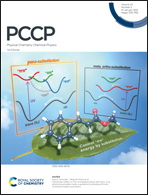Theoretical insights into non-oxidative propane dehydrogenation over Fe3C†
Abstract
Identifying catalysts for non-oxidative propane dehydrogenation has become increasingly important due to the increasing demand for propylene coupled to decreasing propylene production from steam cracking as we shift to lighter hydrocarbon feedstocks. Commercialized propane dehydrogenation (PDH) catalysts are based on Pt or Cr, which are expensive or toxic, respectively. Recent experimental work has demonstrated that earth-abundant and environmentally-benign metals, such as iron, form in situ carbide phases that exhibit good activity and high selectivity for PDH. In this work, we used density functional theory (DFT) to better understand why the PDH reaction is highly selective on Fe3C surfaces. We use ab initio thermodynamics to identify stable Fe3C surface terminations as a function of reaction conditions, which then serve as our models for investigating rate-determining and selectivity-determining kinetic barriers during PDH. We find that carbon-rich surfaces show much higher selectivity for propylene production over competing cracking reactions compared to iron-rich surfaces, which is determined by comparing the propylene desorption barrier to the C–H scission barrier for dehydrogenation steps beyond propylene. Electronic structure analyses of the d-band center and the crystal orbital Hamilton population (COHP) of the carbides demonstrate that the high selectivity of carbon-rich surfaces originates from the disruption of surface Fe ensembles via carbon. Finally, we investigated the role of phosphate in suppressing coke formation and found that the electron-withdrawing character of phosphate destabilizes surface carbon.



 Please wait while we load your content...
Please wait while we load your content...